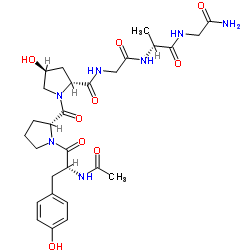Rotigaptide
Modify Date: 2024-01-09 22:02:58

Rotigaptide structure
|
Common Name | Rotigaptide | ||
|---|---|---|---|---|
| CAS Number | 355151-12-1 | Molecular Weight | 617.651 | |
| Density | 1.4±0.1 g/cm3 | Boiling Point | 1187.3±65.0 °C at 760 mmHg | |
| Molecular Formula | C28H39N7O9 | Melting Point | N/A | |
| MSDS | N/A | Flash Point | 671.8±34.3 °C | |
Use of RotigaptideRotigaptide (ZP123) is a novel and specific modulator of connexin 43 (Cx43). Rotigaptide prevents the uncoupling of Cx43-mediated gap junction communication and normalizes cell-to-cell communication during acute metabolic stress. Rotigaptide is a potent antiarrhythmic peptide (AAP) with improved stability and has the potential for the investigation of cardiac arrhythmias-specifically atrial fibrillation[1][2]. |
| Name | Rotigaptide |
|---|---|
| Synonym | More Synonyms |
| Description | Rotigaptide (ZP123) is a novel and specific modulator of connexin 43 (Cx43). Rotigaptide prevents the uncoupling of Cx43-mediated gap junction communication and normalizes cell-to-cell communication during acute metabolic stress. Rotigaptide is a potent antiarrhythmic peptide (AAP) with improved stability and has the potential for the investigation of cardiac arrhythmias-specifically atrial fibrillation[1][2]. |
|---|---|
| Related Catalog | |
| Target |
IC50: connexin 43 (Cx43)[1] |
| In Vitro | Rotigaptide (100 nM; 24 hours) has a positive effect on cycloheximide-mediated decrease in Cx43 protein levels in cultured neonatal ventricular myocytes[1]. Rotigaptide (100 nM; 24 hours) dose not affect INS-1 cell apoptosis itself. And it significantly reduces apoptosis in cytokine-exposed cells ~10% at IL-1b concentrations above 15 pg/ml in rat insulin-producing INS-1 cells[2]. Western Blot Analysis[1] Cell Line: Neonatal cardiomyocytes Concentration: 100 nM Incubation Time: 24 hours Result: Partially prevented the loss of Cx43 protein expression in neonatal cardiomyocytes. Apoptosis Analysis[2] Cell Line: Cx43 deficient INS-1 cells Concentration: 100 nM Incubation Time: 24 hours Result: Ameliorated cytokine-induced apoptosis associated with improved mitochondrial function. |
| In Vivo | Rotigaptide (intravenous administration; 300 mg/kg; single dose) treatment in mice and rats does not result in toxicity in either species. In escalating dose studies, Rotigaptide (continuous intravenous infusion; 5-14 days) in rats (100 mg/kg) and dogs (10 mg/kg) are well tolerated and produces no compound-related effects or histological toxicological findings[3]. |
| References |
| Density | 1.4±0.1 g/cm3 |
|---|---|
| Boiling Point | 1187.3±65.0 °C at 760 mmHg |
| Molecular Formula | C28H39N7O9 |
| Molecular Weight | 617.651 |
| Flash Point | 671.8±34.3 °C |
| Exact Mass | 617.280945 |
| LogP | -3.53 |
| Vapour Pressure | 0.0±0.3 mmHg at 25°C |
| Index of Refraction | 1.607 |
| Glycinamide, N-acetyl-D-tyrosyl-D-prolyl-(4S)-4-hydroxy-D-prolylglycyl-D-alanyl- |
| N-Acetyl-D-tyrosyl-D-prolyl-(4S)-4-hydroxy-D-prolylglycyl-D-alanylglycinamide |
| Rotigaptide |